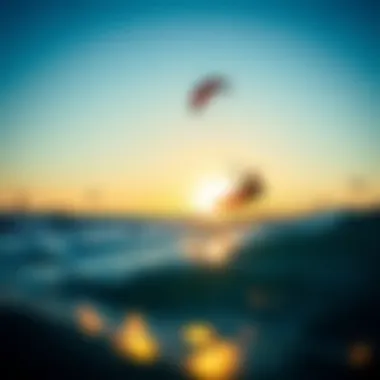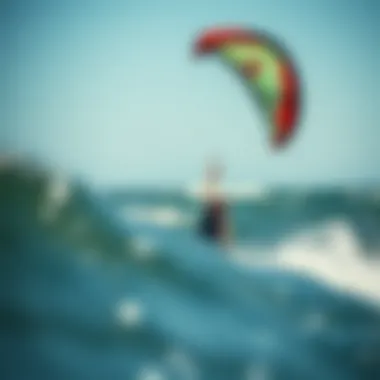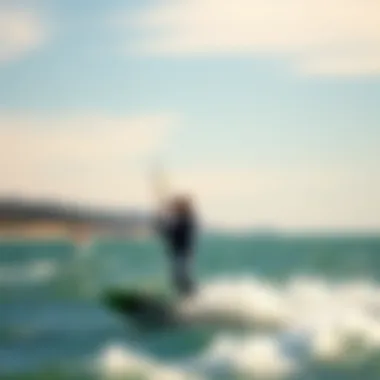Essential Insights for Beginners in Kite Surfing


Intro
Kite surfing is more than just a water sport; it’s a passion that captures the spirit of adventure. Whether you’re gliding across the waves with the wind in your hair or learning how to control a kite, entering this world can be both thrilling and daunting. This guide aims to give you a solid foundation in kite surfing, covering aspects from the gear you’ll need to the essential skills required for mastery.
From utilizing the vast expanse of oceans and lakes to riding the prevailing winds, kite surfing invites enthusiasts from all walks of life to experience the beauty of nature’s power. Not just a sport, but a lifestyle, this activity broadens horizons, not only physically but also socially, as you meet others who share the same zeal for the open water. So, if you're ready to get your feet wet—literally—let’s dive into the essentials of getting started in kite surfing.
Prelude to Kite Surfing
Kite surfing has garnered immense popularity over the years, transforming from a niche water sport into a global phenomenon. As we take the plunge into this guide, it’s pivotal to understand the various facets of kite surfing that make it both intriguing and accessible. This sport blends the exhilarating dynamics of surfing with the audacity of flying a kite, resulting in a unique experience on the water. Here, we will delve into its core elements, benefits, and considerations that newcomers to this thrilling sport should ponder.
Understanding the Sport
Kite surfing, at its essence, involves harnessing the power of the wind to propel oneself across water on a board. It functions on the premise of using a controllable kite tethered to the rider by a harness. The basic mechanics may sound straightforward, but mastering kite surfing entails considerable knowledge and skill. Familiarity with the wind patterns, weather conditions, and the equipment is crucial to navigating the learning curve successfully.
Often, beginners may find themselves facing overwhelming choices and information overload. For instance, it’s common to encounter various kite styles, different board designs, and types of harnesses—each tailored for specific conditions and skill levels. Thus, it's essential to approach this sport with patience and a readiness to learn from experienced kite surfers and instructors.
The Appeal of Kite Surfing
The allure of kite surfing goes beyond mere thrill-seeking. The feeling of riding over waves, propelled by the wind, offers an unparalleled sense of freedom that is hard to replicate in other sports. Many enthusiasts describe it as a dance with nature, where the ocean and wind become partners in a perfectly orchestrated performance.
Moreover, the sense of community in kite surfing can be irresistible. Riders often share tips, celebrate each other’s progress, and form bonds over their mutual love for the sea. Participating in local kite surfing clubs or events can be a great way to gain motivation, make friends, and learn from seasoned professionals.
"The vastness of the water below you and the endless sky above provides a perspective that remains unmatched by most other outdoor activities."
In summary, the combination of mechanics, mastery, and the joyful camaraderie found in kite surfing creates an inviting atmosphere for newcomers. Understanding the sport and grasping its appeal is the first step to embarking on this exciting journey into kite surfing.
Essential Gear for Beginners
Kite surfing is not just about riding the waves; it's also about having the right gear to ensure a safe and enjoyable experience. When you're starting out, the equipment you choose plays a crucial role in your journey. The right gear not only enhances your performance but also boosts your confidence on the water. If you're well-equipped, you can focus on learning the ropes, rather than worrying about whether your kite will withstand the wind.
There are a few core pieces of equipment beginners must consider, including kites, boards, and safety gear. Each element is important in its own right, and understanding the nuances can make a world of difference.
Choosing the Right Kite
Selecting a kite is perhaps the most significant decision you'll make as a newbie kite surfer. The kite you choose affects your stability, control, and, in essence, your overall experience in the water. When picking a kite, consider its size, type, and wind range. A larger kite is better for lighter winds, while a smaller kite suits high wind conditions. It’s often recommended for beginners to go with a bridled or delta kite, as they provide better stability and are easier to control.
Also, don't overlook the importance of the kite's material. A lightweight, durable material can translate to better performance and longevity of the equipment. Any seasoned rider will tell you that a good quality kite can last for years, making it a worthwhile investment for those serious about the sport.
Selecting a Board
The board you select complements your kite and significantly influences your riding experience. Boards come in various shapes and sizes, and the right one can give you an edge as you learn. For beginners, a wider and longer board is generally more stable, making it easier to learn balance and control.
In addition, consider your future goals. If you aim to advance in tricks and jumps, a freestyle board might catch your interest later on. At this stage, however, focusing on comfort and stability is crucial. A well-rounded board can help you transition smoothly into different styles as you progress.
Safety Equipment
Safety should remain a priority in kite surfing. Even for beginners, it’s essential to have appropriate safety gear to mitigate risks and injuries as you learn.
Impact Vest
An Impact Vest is crucial when kite surfing, especially for beginners who might take a tumble. This vest does an excellent job of absorbing shock, protecting your torso from potential impacts during falls. Look for vests that offer flexibility without sacrificing support.
A noteworthy characteristic of the Impact Vest is its buoyancy. This feature can keep you afloat if you find yourself in a sticky situation. While many beginner-level vests provide essential protection, some models can feel more bulk than you'd like in the water. Nonetheless, having this gear significantly increases your confidence.
Harness
The harness plays a pivotal role in your kite surfing experience. It connects you to the kite and spreads the load across your body, allowing you to ride more comfortably. Most beginners will opt for a seat harness; it’s convenient and offers decent support.
One striking aspect of a harness is its ease of use. Beginners can quickly learn to put it on and take it off, making the learning process smoother. Some may find it cumbersome at first, but once you get used to it, it's a game changer. Remember that a quality harness won't just save you from discomfort—it will also improve your control over the kite.
Helmet
Investing in a helmet is another important step toward ensuring safety while kite surfing. Yes, helmets may seem like an unnecessary fuss, but any expert rider would argue otherwise. A good helmet offers protection against any falls or crashes, especially when you’re learning.
Most helmets are designed to be lightweight while providing necessary protection. This allows you to move freely and not feel weighed down. However, beginners should prioritize proper fit to ensure efficient protection. A snug fit can prevent the helmet from sliding off or wobbling as you ride, keeping you protected and comfortable.
Fundamental Skills for Kite Surfing
When embarking on your kite surfing journey, mastering fundamental skills is not just beneficial; it's crucial for your safety and enjoyment on the water. These skills serve as the foundation upon which more advanced techniques can be built. Without a solid grip on these basics, the chances of mishaps increase dramatically. Also, knowing the ins and outs of kite control and riding the board can make the entire sport more enjoyable. Here, we delve into two essential areas: kite control and board riding techniques.
Kite Control Basics


Kite control is where it all begins in kite surfing, acting as the linchpin that connects you to the wind and the water. Being able to navigate your kite effectively can be the difference between soaring through the air or ending up in the drink.
- Body Positioning: Correct body positioning is key. You should maintain a slight bend in your knees to absorb the pull of the kite while keeping your body centered over the board. This balance will aid in responding quickly to shifts in wind direction or power.
- Understanding Wind Zones: Familiarizing yourself with wind windows is imperative. The wind primarily comes from behind the kite to the sides and even above it. Understanding how these areas impact your lift and speed plays a critical role in your kite handling ability.
- Steering the Kite: To steer the kite, you move the control bar backward and forward while shifting your weight. Pulling on one side directs the kite in that direction, giving you the ability to navigate quickly. The more precise your movements, the better your kite will respond. It's all about ability and finesse.
- Practice: Try practicing on land before hitting the water. Running through drills on the beach with a trainer kite can help solidify these concepts and build muscle memory. Learning to control a kite without the board can make the dual interaction less daunting when it comes time to ride.
"Mastering the art of kite control is like learning to dance with the wind; the more you practice, the better you move."
Board Riding Techniques
Once you’ve got kite control down, it's time to focus on board riding techniques. Successfully getting on and staying on the board adds a layer of complexity that can seem daunting at first. However, with the right strategies, this phase can be conquered.
- Getting Up on the Board: Start by lying on your stomach, holding the handle of the control bar. When the kite pulls you, shift your weight onto your feet and push your back foot into the board to lift yourself up. The initial few tries might feel wobbly, but persistence is key. Your body will naturally find the balance point.
- Gaining Speed: To gain speed, lean back slightly and keep your back foot pressed down. The angle that your kite sits will greatly impact your acceleration; angling it slightly higher will give you a boost. Remember, speed enhances stability, enabling you to ride smoother.
- Turning Techniques: Mastering turns can unlock new dimensions in your riding. To initiate a turn, edge your board by directing your weight onto your heels and pulling on the rear hand of the control bar. This action helps to slow tension on the kite, and using your movements to guide the kite will keep you flowing smoothly.
- Practice Makes Perfect: Like kite control, board riding requires practice. Try practicing quick turns and speed adjustments in a safe area, like a calm lagoon, to help refine these techniques without the stress of strong currents or crowded waters.
Developing your kite control and board riding skills can rapidly enhance your kite surfing experience, making you a safer and more confident rider. As you progress, these skills will unlock more complex techniques, allowing you to truly enjoy the freedom and thrill that kite surfing offers.
Locations for Kite Surfing
Choosing the right location for kite surfing is crucial, as it directly influences not only your safety but also your enjoyment of the sport. Real estate in the kite surfing world hinges on finding spots that offer consistent winds, manageable water conditions, and a welcoming community. Whether you’re a novice learning the ropes or a seasoned rider looking for the thrill of new challenges, knowing where to go can make or break your experience on the water.
Top Destinations
Coastal Areas
Coastal areas stand out as prime spots for kite surfing due to their expansive open water spaces and often reliable wind conditions. The beauty of kite surfing at the beach is hard to resist—the sound of crashing waves and the sensation of gliding across the water while the sun kisses your skin is enchanting. The key characteristic of coastal spots is the direct access they offer to the ocean, which means you can tackle various levels of waves depending on your skill set.
One unique feature of coastal areas is their diversity. Beaches around the world, from the tropical oasis of Maui to the rugged shorelines of Cape Cod, cater to different abilities. Advanced kite surfers can enjoy challenging wave conditions, while beginners may prefer sandy beaches with flatter waters. However, the drawbacks might include certain safety hazards like rip currents or crowded areas, so always check local guidelines before diving in.
Lakes
Lakes may not be the first thought for kite surfing, but they can be a hidden gem for beginners and those looking for a different experience. Many lakes offer flat, calm waters which are ideal for learning how to control the kite without the unpredictability of ocean waves. The key characteristic here is the often lighter and more consistent winds found on lakes, making it a comfortable choice for those just starting out.
For instance, the expansive waters of Lake Tahoe provide stunning scenery paired with adaptable wind conditions, making it a popular destination. However, one must remember that lakes can sometimes be subject to sudden weather changes due to their proximity to land, which can catch inexperienced kite surfers off-guard. Always stay alert and ready for changing conditions.
Windy Regions
Windy regions are the bread and butter for serious kite surfers seeking exhilaration. These areas, characterized by consistent and powerful winds, draw enthusiasts from all corners of the globe. Locations like Tarifa in Spain or the Inner Hebrides in Scotland provide reliable conditions year-round. The major advantage here is the abundant wind that makes kite surfing almost an everyday occurrence.
Windy regions’ unique feature is their appeal to both beginners and pros alike. They often host kite surfing communities that foster learning and sharing of skills. On the flip side, these locations can be challenging. The strong winds need to be respected, as they require a higher level of experience and physical ability to navigate safely.
Evaluating Conditions
Before heading out, it’s vital to evaluate the conditions of your chosen location. The safety and enjoyment of your session largely depends on this understanding.
Wind Patterns
Understanding wind patterns is pivotal for kite surfers. They dictate everything from how you set up your kite to the kind of tricks you can attempt. A reliable wind pattern typically involves steady winds with consistency in speed. The key characteristic of good wind patterns is their predictability, allowing kite surfers to plan their sessions more effectively.
A unique aspect to consider is how local weather systems can influence wind conditions. They can change rapidly, wherein a beautiful sunny day can quickly morph into stormy winds. Thus, it’s always beneficial to keep an eye on local forecasts and wind reports the days leading up to your session.
Water Conditions
Water conditions play an equally critical role in the kite surfing experience. Smooth, flat waters allow beginners to focus on mastering their skill without the distraction of surf. Conversely, choppy water can be thrilling for those with experience.
The unique advantage provided by favorable water conditions is the freedom they afford kite surfers to practice various techniques. However, beware of the disadvantages as well—bodies of water react differently to varying wind conditions. An area that seems friendly in calm conditions might become treacherous during gusts. Always reassess the water conditions before launching your kite to ensure a safe ride.
Training and Instruction
Diving into kite surfing without proper training can be like jumping into the deep end without knowing how to swim. Training and instruction are paramount; they lay the groundwork for both safety and skill development. Whether you're a newcomer or someone looking to brush up on your technique, finding the right instructional pathway is crucial to mastering the sport. Plus, understanding how wind patterns affect your ride can make all the difference. Overall, proper guidance not only helps in avoiding accidents but also accelerates the learning curve.
Finding an Instructor
When it comes to kite surfing, having a skilled instructor is like having a lighthouse guiding you through a foggy night. A qualified instructor ensures that you're not just safe but also learning the ins-and-outs of the sport effectively. Look for someone who's certified by a recognized organization such as the International Kiteboarding Organization (IKO) or the Professional Air Sports Association (PASA). These certifications speak volumes about an instructor's capability and knowledge. Alternatively, check out local kiteboarding clubs and forums like those on reddit.com to hear feedback on instructors in your area.
Taking Lessons
Beginner Courses
Beginner courses are often where the journey begins for most kite surfers. These courses are tailored to offer newcomers a solid foundation, covering essential skills like kite control, launching, and landing. What sets these courses apart is their structured approach, often breaking down complex maneuvers into digestible steps.
Some beginner lessons focus strictly on the theoretical aspects initially, while others combine theory with practical training on the water. The combination ensures that you’re not just getting your feet wet—you're diving into understanding what makes kite surfing both thrilling and safe. One key advantage is that with a trained instructor, you’ll receive real-time feedback, helping you correct mistakes before they become habits.
However, one downside might be the time it takes to complete these courses—many span several weeks, limiting your time on the water.


Advanced Techniques
Once you have the basics down, advanced techniques can elevate your kite surfing experience to new heights, literally. These lessons typically cover more intricate maneuvers such as jumps, tricks, and even wave riding if you venture into that territory. Advanced techniques classes often appeal to those who feel comfortable with the kite and on the board but want to spice things up.
A distinct feature of these courses is the emphasis on refining existing skills while adding complexity. You might find yourself perfecting transitions or learning how to execute flips. This tailored approach allows you to focus on areas that need improvement, which can be immensely satisfying. However, it can also be intimidating as the challenges ramp up and the learning curve steepens.
"Good instruction isn't just about teaching; it's about inspiring confidence and fostering a passion for the sport."
For more on instructional courses and community feedback, consider visiting forums or local kite surfing centers. You can find a wealth of information at websites like britanica.com or instructional videos through specialized YouTube channels.
Safety Protocols in Kite Surfing
Engaging in kite surfing mixes the thrill of adventure with the unpredictability of nature. However, the winding ribbons of wind and water carry their own risks. Therefore, adhering to safety protocols becomes essential for all kite surfers, from rookies to pros. These guidelines not only safeguard individual kite surfers but also promote a culture of safety within the sport.
Safety protocols encompass specific guidelines and best practices that mitigate potential hazards. By familiarizing yourself with these aspects, you can enjoy the exhilarating experience of kite surfing while minimizing the likelihood of accidents or injuries.
Understanding Risks
Kite surfing, while enthralling, introduces various risks that can transform a fun-filled day at the beach into a hazardous situation. Here are some of the key risks to grasp before spinning your first kite:
- Environmental Hazards: Wind conditions can shift suddenly. Unpredictable gusts can make controlling the kite challenging. Additionally, underwater obstacles, currents, and waves can pose serious dangers.
- Equipment Failure: Kite surfing gear, such as lines and kites, can wear down over time. A sudden failure, whether from a frayed line or a malfunctioning kite, can lead to loss of control or injury.
- Collision Risks: The crowded waterways during peak hours can cause collisions not just with other kitesurfers but also with boats and swimmers. This potential for accidents necessitates vigilance and respect for others in the water.
To stay ahead of these risks, it’s crucial to have a comprehensive understanding. Simple vigilance—like watching the wind patterns and knowing the area—can go a long way in ensuring safety.
Emergency Procedures
No matter how careful you are, accidents can happen. Therefore, being equipped with a solid emergency protocol is not just wise; it can be lifesaving. Here’s what you should consider:
- Know your Area: Familiarize yourself with the terrain and depth of the water. Understanding the local conditions will help you react quickly if something goes wrong.
- Emergency Signals: Establish clear signals with your peers. If someone encounters trouble, a universal signal can alert others to assist swiftly.
- Hydration and First Aid Management: Always carry a first-aid kit and ensure someone in your group is trained in basic first aid. Hydration is equally important, especially on hot days when fatigue can set in quickly.
- Emergency Contacts: Keep an updated list of emergency contacts, including local authorities and lifeguards. In case of severe incidents, having quick access to help can make a significant difference.
- Self-Rescue Techniques: Learn self-rescue techniques, such as how to re-launch your kite if it tips over or how to swim back to safety if you find yourself separated from your gear.
"Preparation and awareness often dictate the line between an exhilarating experience and tragedy."
In short, understanding safety protocols in kite surfing reduces the risks associated with this dynamic sport. By educating yourself on potential hazards and establishing an effective emergency response, you can protect yourself and those around you, ensuring that kite surfing remains a joyful activity.
For further reading on safety practices, you can refer to resources provided by the American Kiteboarding Association and International kitesurfing Organization.
Environmental Considerations
Kite surfing, while exhilarating, carries with it a set of responsibilities toward the environment. As individuals who enjoy gliding across the waves and harnessing the wind's power, it is crucial to maintain a balance between enjoyment and preservation of natural spaces. This segment delves into the imperative need for environmentally conscious practices in the kite surfing community, underscoring both the positive impacts and considerations that should be kept in mind.
Sustainable Practices
One of the foundational aspects of kite surfing is ensuring that one's recreational activities do not lead to significant erosion of natural habitats or pollution in waterways. A few sustainable practices are particularly noteworthy:
- Choose Eco-Friendly Gear: When selecting equipment, prioritize brands that manufacture kites and boards from sustainable materials. Look for companies focused on reducing their ecological footprint and those taking action toward environmental rehabilitation. Some brands have begun using recycled plastics and eco-friendly production methods, appealing to environmentally conscious kite surfers.
- Leave No Trace: Kite surfers should always adhere to the principle of "leave no trace." This includes cleaning up after oneself on the beach, disposing of litter responsibly, and avoiding disturbing local wildlife. Practicing this sensibly contributes to maintaining clear waters and sand areas, ensuring they remain pristine for future generations.
- Respect Local Regulations: Many kite surfing locations have specific guidelines to minimize ecological impacts. Always familiarize yourself with these regulations, which may include designated zones for surfing, seasonal restrictions, or restrictions on specific types of equipment. Compliance helps preserve delicate ecosystems and can foster a stronger bond between the surfing community and local authorities.
By taking these sustainable steps, kite surfers can enjoy their sport while actively participating in the preservation of the environments they cherish.
Conservation Efforts
In addition to practicing sustainability on an individual level, joining broader conservation efforts can amplify impact. Kite surfers benefit from connecting with organizations focused on preserving coastal and marine ecosystems. Here are some ways to engage:
- Partnering with Environmental Groups: Many local and international organizations focus on marine conservation. Participating in beach clean-ups, habitat restoration projects, or educational initiatives hosted by these groups allows kite surfers to contribute positively. Engaging actively increases awareness of environmental issues affecting coastlines.
- Advocacy for Protected Areas: Some locations, particularly popular kite surfing spots, are subject to environmental threats. Advocating for the designation of marine protected areas can help safeguard ecosystems and ensure that both natural beauty and recreational opportunities are maintained. Kite surfers can play a pivotal role by voicing support for policies designed to protect these fragile environments.
“The best way to find yourself is to lose yourself in the service of others.” — Mahatma Gandhi. Community involvement fosters a spirit of camaraderie while safeguarding our cherished kite surfing locales.
In summary, recognizing and addressing environmental considerations in kite surfing isn't simply an option—it's a necessity. As thrill-seekers, kite surfers have a unique opportunity to lead the charge for sustainable recreation, ensuring that the landscapes we love remain vibrant and healthy for years to come.
Community Involvement
Community involvement is a cornerstone in the kite surfing world, providing novices and experienced kite surfers alike with a chance to connect, learn, and grow within this thrilling sport. It fosters a shared passion, encourages safety, and promotes sustainable practices, which are crucial for the well-being of both participants and the environment.
Joining a community not only amplifies motivation but also enhances the overall kite surfing experience. Here’s how diving into community involvement can be beneficial:
- Support and Mentorship: Being part of a group allows beginners to learn from those who have been through the ropes. We often say that experience is the best teacher, and this is especially true in kite surfing.
- Access to Resources: Many clubs and organizations offer resources not readily available to solo flyers, such as safety briefs, gear rental services, and organized training sessions.
- Networking Opportunities: Connections made through clubs can lead to friendships and collaborations that enhance one’s kite surfing journey.
- Environmental Stewardship: Community groups often organize beach cleanups and conservation initiatives, harnessing collective strength to protect our beloved kite surfing environments.
With these benefits in mind, let’s explore how individuals can immerse themselves into kite surfing communities.
Joining Clubs and Groups
Becoming a member of a kite surfing club or group brings members closer together, offering camaraderie and shared experiences. Clubs often create a welcoming space for individuals of all skill levels. They frequently host training events, workshops, and social gatherings, providing an appropriate platform for newer kite surfers to mingle with experienced ones. And as the saying goes, "Many hands make light work."


It's essential to choose a club that aligns with your interests and skill level. Look for local clubs that hold frequent events, as they generally cater better to newcomers. Many clubs will also offer introductory courses to help you ease into the basics, and who doesn't love a little extra help?
Participating in Events
Events in kite surfing can vary widely, attracting enthusiasts from various backgrounds. Engaging in these activities brings numerous advantages to both participants and the kiteboarding community as a whole.
Competitions
Competitions serve as a showcase for skill but also allow kite surfers to push their boundaries. Participating in competitive events can elevate one's riding level and help gauge progress. Moreover, the competitive spirit breeds camaraderie and sportsmanship, important values that resonate throughout the kite surfing culture.
One particularly notable aspect of competitions is their ability to attract spectators and sponsors, providing important visibility for the sport. They encourage everyone to strive for excellence, which can be an inspiring drive for new and experienced surfers alike. However, it's worth noting that competitions can also introduce pressure, making some choose to participate merely for enjoyment instead.
Festivals
Festivals, on the other hand, capture the lively spirit of kite surfing beyond the competitive realm. These celebrations often include music, art, food, and, of course, plenty of riding time. Festivals present a fantastic way to connect with fellow surf enthusiasts, engaging with a broader community while celebrating the joy of the sport.
A unique feature of kite surfing festivals is the spirit of participation; anyone can join, irrespective of their skill level. This inclusivity is beneficial, allowing newcomers to observe and learn from veterans, while seasoned surfers get to share their knowledge and techniques. Furthermore, festivals often emphasize the importance of environmental awareness, cultivating a sense of responsibility toward our playing fields.
Ultimately, whether through competitions or festivals, becoming active in kite surfing events enriches your experience. By getting involved, you not only enhance your skills but also contribute to a supportive and vibrant community.
Technology and Innovations in Kite Surfing
The world of kite surfing has seen a substantial transformation, particularly due to advancements in technology. These innovations not only enhance performance but also improve the overall experience for riders. It’s an ever-evolving ecosystem where gear designs and techniques are constantly being refined.
Gear Advancements
Recent years have ushered in a new era of gear advancements that cater to both novice and experienced kite surfers. Equipment manufacturers like Naish and F-One are at the forefront of these developments, integrating cutting-edge materials and designs into their products.
- Kite Materials: Modern kites are crafted from lighter, stronger materials such as ripstop nylon that minimizes drag and increases durability. Depending on wind conditions, different kite shapes, like delta and bow kites, provide specific advantages, improving lift and control.
- Board Technology: Kite boards have also evolved significantly. They now incorporate features such as concave designs and flexible flex patterns that enhance speed and responsiveness on the water. Brands like Slingshot and Liquid Force are known for their innovative designs that aim to improve edge control and stability.
- Foil Technology: One of the most exciting advancements is the introduction of foil kites, which allow riders to glide above water using hydrofoils. This not only opens up new possibilities for riding in lighter winds but also provides a completely different sensation and maneuverability.
These gear advancements lead to greater accessibility and enhance the overall kite surfing experience for enthusiasts of every skill level.
Emerging Trends
As new technologies develop, certain trends are surfacing that are likely to shape the future of kite surfing. Staying informed about these trends can provide avid kite surfers with an edge, both in performance and style.
- Sustainable Materials: There’s a growing movement within the kite surfing community towards the use of eco-friendly materials. Companies are increasingly focused on reducing their carbon footprint by using recyclable materials and manufacturing processes.
- Smart Technology: The integration of smart tech into kite surfing gear is just around the corner. Think GPS-enabled kites that track performance metrics or wearables that monitor a rider's health metrics like heart rate during sessions.
- Personalization: Another emerging trend is the customization of gear. Riders can configure their kites and boards to suit their individual styles and preferences. Whether it’s a specific kite size or personalized artwork, customization options are becoming more mainstream.
Insurance and Liability
In the thrilling world of kite surfing, safety should never take a backseat. Understanding insurance and liability isn’t just a nice-to-have; it's a crucial element for anyone who wishes to engage in this exhilarating sport. The unpredictable nature of wind and water means that accidents can happen, and being covered can save you from a heap of trouble—both financially and legally. Insurance not only helps with medical expenses resulting from incidents but can also provide coverage for damage to your gear or liability towards others.
Understanding Coverage
When it comes to kite surfing, choosing the right insurance policy can seem overwhelming. Here are some key aspects to consider:
- Personal Injury: This covers you in case of an accident that requires medical attention. Make sure your policy includes coverage for competitive events as well.
- Property Damage: Accidents can lead to damage to personal property, such as boats or even other kitesurfers' gear. This aspect of insurance helps cover damages you're liable for.
- Theft Coverage: Kite gear can be expensive and is often at risk of theft. Ensure your policy covers gear loss due to theft.
- Liability Coverage: This is a must-have if you're out on crowded beaches or during events. It protects you against claims made by others who may be injured as a result of your actions while kite surfing.
It's important to read the fine print of any policy you choose. Not all policies are created equal, and exclusions can make a big difference in case you need to file a claim.
"An ounce of prevention is worth a pound of cure."
Assessing Risks
Assessing risks in kite surfing goes hand in hand with having proper insurance. Here’s how to evaluate potential hazards:
- Location: Not all spots are created equal. Some areas may have strong currents or rocky bottoms that pose significant risks.
- Wind Conditions: Wind can turn from friendly to fierce in a heartbeat. Always check forecast models and local conditions before hitting the water.
- Crowd Density: Surfing in densely populated areas can increase the likelihood of accidents, both for yourself and other water sports enthusiasts. If a session gets too crowded, it might be wise to pack it in.
- Gear Condition: Always inspect your equipment before heading out. Worn lines or frayed kites can lead to failures that may be dangerous.
- User Experience: Knowing your limits is vital. Beginners should steer clear of overestimating their skills. If something doesn’t feel right, it’s best to avoid the water until you feel confident.
Understanding these elements and how they integrate with your insurance can help you navigate the thrilling—yet risky—landscape of kite surfing safely.
Closing Thoughts on Kite Surfing
Kite surfing, often seen as a pursuit for the adventurous, offers more than just adrenaline-inducing thrills. It’s a multifaceted sport that fosters a profound respect for nature and the ocean. Closing this exploration, it’s important to reflect upon both personal growth and the broader implications of engaging with such a dynamic environment.
Reflecting on Your Journey
Looking back, every kite surfer has a unique story. Each attempt to master the kite, every wipeout endured, and the exhilarating moments of catching the right wind contribute to a larger narrative of perseverance and delight. As you navigate the waves, consider the progress made, not just in skills but also in self-awareness.
- Think about the first time you felt the wind lift you off the water, that jolt of excitement mingling with fear.
- Remember the days when things didn’t go as planned; they teach patience and resilience.
- Embrace the community—friends made on the beach or fellow surfers cheering you on.
These memories form the backbone of your surfing journey. Each session on the water sharpens your focus and increases your understanding of wind and water dynamics, enhancing not just your technique but also your appreciation for nature’s beauty.
Future Endeavors
As you look ahead, the journey doesn’t have to stop here. Consider setting new goals to keep the thrill alive. Here are some avenues to explore:
- Advanced Techniques: Delve into freestyle tricks or wave riding to elevate your skills further. Techniques like backflips or jumps can add flair to your surfing.
- Travel Opportunities: Plan trips to international kite surfing hotspots, from the turquoise waters of the Caribbean to the windy coasts of Spain. Every new location offers different challenges and experiences to enrich your practice.
- Environmental Stewardship: Get involved in local beach clean-ups or conservation initiatives. Protecting the environment you love is crucial for the sustainability of kite surfing.
- Building Community: Think about joining a kite surfing club or participating in competitions and festivals. Forming connections with fellow enthusiasts can lead to lifelong friendships and shared adventures.
The possibilities are as vast as the ocean itself. Keep challenging yourself and embrace the ever-evolving nature of kite surfing. Remember, every ride is both an adventure and a lesson, forging a deeper bond with the craft and the world around you.















